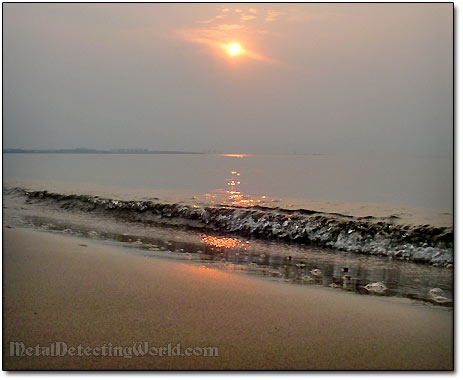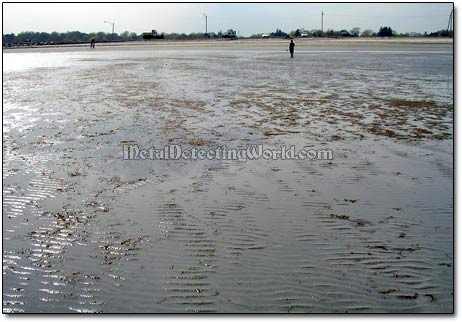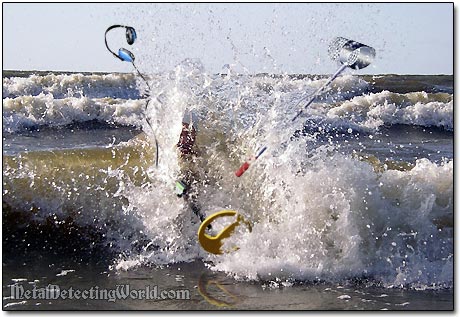Types of Metal Detecting Activities, page 19:
BEACH HUNTING
BEACH HUNTING ON WET SAND and WADING IN SHALLOW SURF
Wet sand detecting is usually done on the wet surface of the beach - in transition area where dry and wet sands combine, and in the wet sand area expanding from the surf line into the ocean during low tides.

The width of the wet sand area available for searching can range from a few meters to a hundred yards (or more) during the low tide. If you use the tide charts published in the local newspaper, you can increase the scope of your action by choosing to hunt the vast wet sand areas that become available during a few hours (usually four) of low tide. In this case, you can still use your land metal detector and would not have to take it into the water to find swimmers' jewelry.
Low Tide Freed a Hundred Yards of Wet Sand at Atlantic Ocean Beach

Sometimes, to increase his/her chances to find "that 5,000-Dollar ring," a beach hunter ventures into the shallow surf and begins to search as long as the water level is below the control box (electronics housing) if a regular land metal detector is used. Even though the detector's search coil is submersible, it is not advisable to use a regular land detector in water at all because of a high probability of accidental submersion of the control box. It could be caused by losing one's balance, tripping and falling, accidental flooding of a detector during target recovery, or being suddenly hit by a strong wave.

In any of these cases, a regular land metal detector will not survive, and hot drying of the control box with a hair blower will not resurrect it.
If your land metal detector can overcome the effects of salt water, and you decide to take a risk and search for gold jewelry in shallow waters, try not to submerse the coil deeper than the lower end of the upper shaft (stem) of your detector. Otherwise, you will experience a difficulty swinging the search coil in water, maintaining the coil moving discipline, and keeping the coil flat on the bottom. Unlike the search coils designed especially for use with underwater metal detectors, search coils of land detectors do not have an extra weight and will resist moving through water.
Also one should be aware of water getting inside the detector's stem since not all units have a plug to prevent water from running into the controls housing. To be on a safe side, drain the lower stem (shaft) immediately after using a detector in water. If water is not drained, it may flood the electronics housing or battery compartment the first time the search coil is placed higher than the control box.
How Jewelry Ends Up in Wet Sand and Shallow Surf
1) Wet sand hunting is very lucrative because lots of jewelry is lost particularly during swimming. Losing jewelry by swimmers is caused by the effect of finger shrinking which takes place during swimming and playing in water that is cooler than air. As a result, all kinds of gold rings easily slip off the swimmer's fingers during the prolonged submersion, especially if slippery sunscreen or suntan oil were applied prior to swimming.
"Swim Rush"

2) A larger amount of jewelry and coins is pulled from the dry sand beach into the water by powerful tides, and then collected in a zone that stretches between waterline and the low-tide mark.
CONTINUED ON NEXT PAGE...